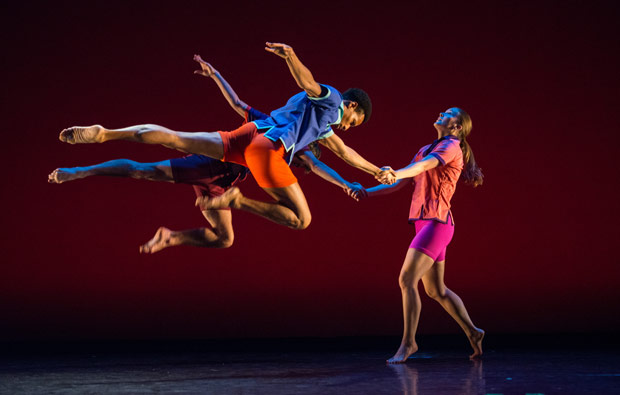
© Stephanie Berger. (Click image for larger version)
Sounds of India festival
Mark Morris Dance Group: Serenade, Tamil Film Songs in Stereo pas de deux, O Rangasayee, Pure Dance Items
Kerala Kalamandalam: Dussasana Vadhom (The Killing of Dussasana)
★★★★✰
New York, Gerald W. Lynch Theater at John Jay College
29, 31 October 2016
whitelightfestival.org/series/sounds-of-india
markmorrisdancegroup.org
www.kalamandalam.org
Indian Autumn
This year’s White Light Festival, at Lincoln Center, has spawned a mini-festival of its own, Sounds of India, curated by the modern-dance choreographer Mark Morris. Why Morris? Because he has been going to India since the eighties and has an intense interest in Indian music and dance. He regularly spends time at the dance ashram Nrityagram, home of the wonderful Odissi dancer and choreographer Surupa Sen.
Morris first visited India in 1981, when he traveled there as a member of Laura Dean’s company. A few years later, in 1984, he presented an evening of his own work at the Brooklyn Academy of Music. On the program was Gloria, set to Vivaldi’s choral masterpiece, a work that is still regularly performed. But that program also included a tour-de-force for Morris himself, O Rangasayee, set to a raga sung by one of the most popular vocalists in India, M. S. Subbulakshmi. In a way, the solo sealed his fame. Arlene Croce, the New Yorker’s dance critic at the time, declared Morris to be “one of the world’s marvelous dancers.” But he never performed the solo again after that year, nor did anyone else, until now. He has revived it for the festival, where it is being performed by Dallas McMurray, a ten-year veteran of the company.
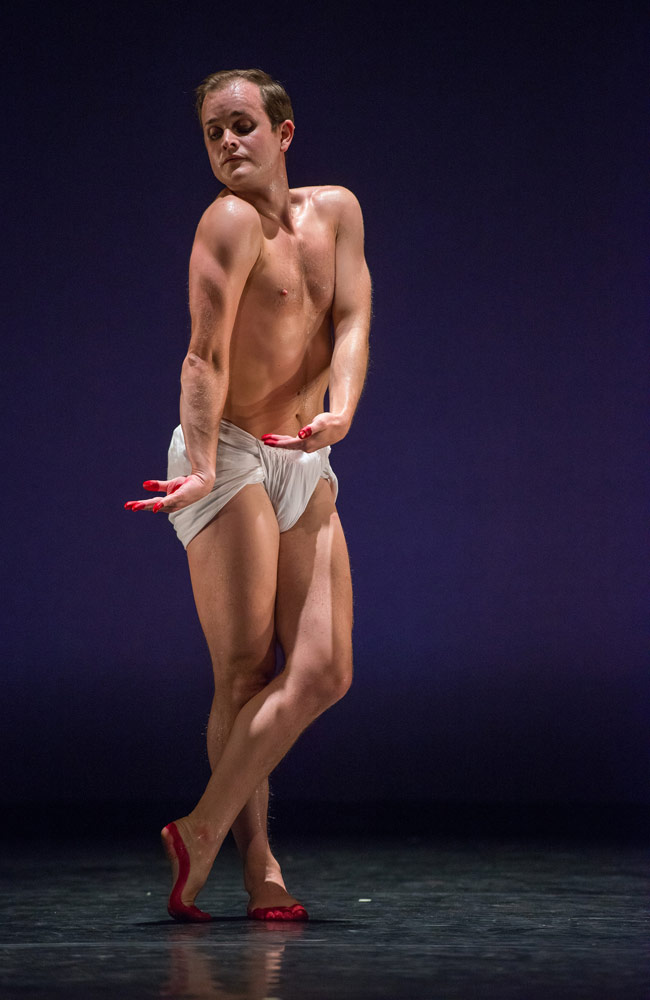
© Stephanie Berger. (Click image for larger version)
It is the centerpiece of a program that also includes the wonderfully funny Tamil Film Songs in Stereo pas de deux (1983), the 2003 solo Serenade, and a new work, Pure Dance Items. McMurray dances the 20-minutes solo differently than Morris did; where Morris was almost feral, McMurray is quietly introspective. He shows the steps without commenting on them, gradually drawing the audience into his world. It’s less spectacular, in a way – he doesn’t exert massive amounts of energy – but impressive nonetheless. The dance is constructed as a series of variations on walking, rocking, balancing, turning, jumping, swaying. Steps return again and again, but with different dynamics and at different speeds, traveling in different directions – this reflects the structure of the music, which is cyclical. There is a gradual crescendo, ending in grotesque twists of the body and dramatic falls to the floor. It is still a tour de force, just a less dramatic one.
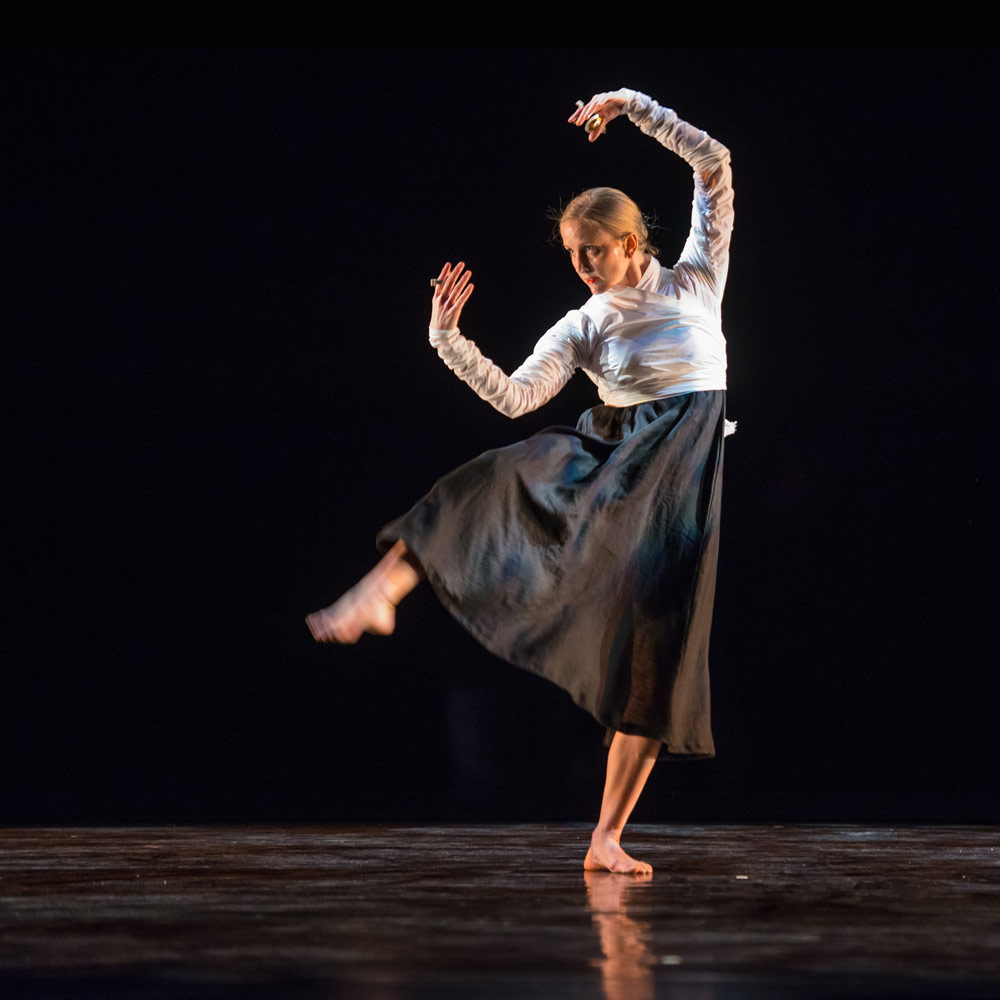
© Stephanie Berger. (Click image for larger version)
Serenade, the other solo of the evening, was performed by Lesley Garrison, accompanied onstage by the guitarist Robert Belinic and percussionist Stefan Schatz. It is made up of small miniatures, set to Lou Harrison’s Serenade for Guitar, each with a faintly “eastern” feel. There are hints of Japanese dance (a fan dance), Indian dance (bharata natyam arms), Turkish Sufi dancing (spins), with a nod to Martha Graham and the exotica of Ruth St. Denis. Garrison is extraordinary in it, rhythmic and remote and grounded in the movement.
Morris is known for his humor, and Tamil Film Songs is certainly one of his most deliciously funny pieces. The titular songs are duets in which a man seems to guide a woman through vocal exercises, as in a voice lesson. The woman’s voice becomes increasingly broken as his gets louder and more berating. Morris has translated the situation to a dance lesson, in which a narcissistic teacher (Brian Lawson) clad in ludicrous turquoise tights, puts a hard-working student (Stacy Martorana) through her paces. He’s more interested in admiring himself in the mirror than in teaching his pupil. Lawson and Martorana – dopey but never despairing – were hilarious together, without stepping over the line into slapstick.
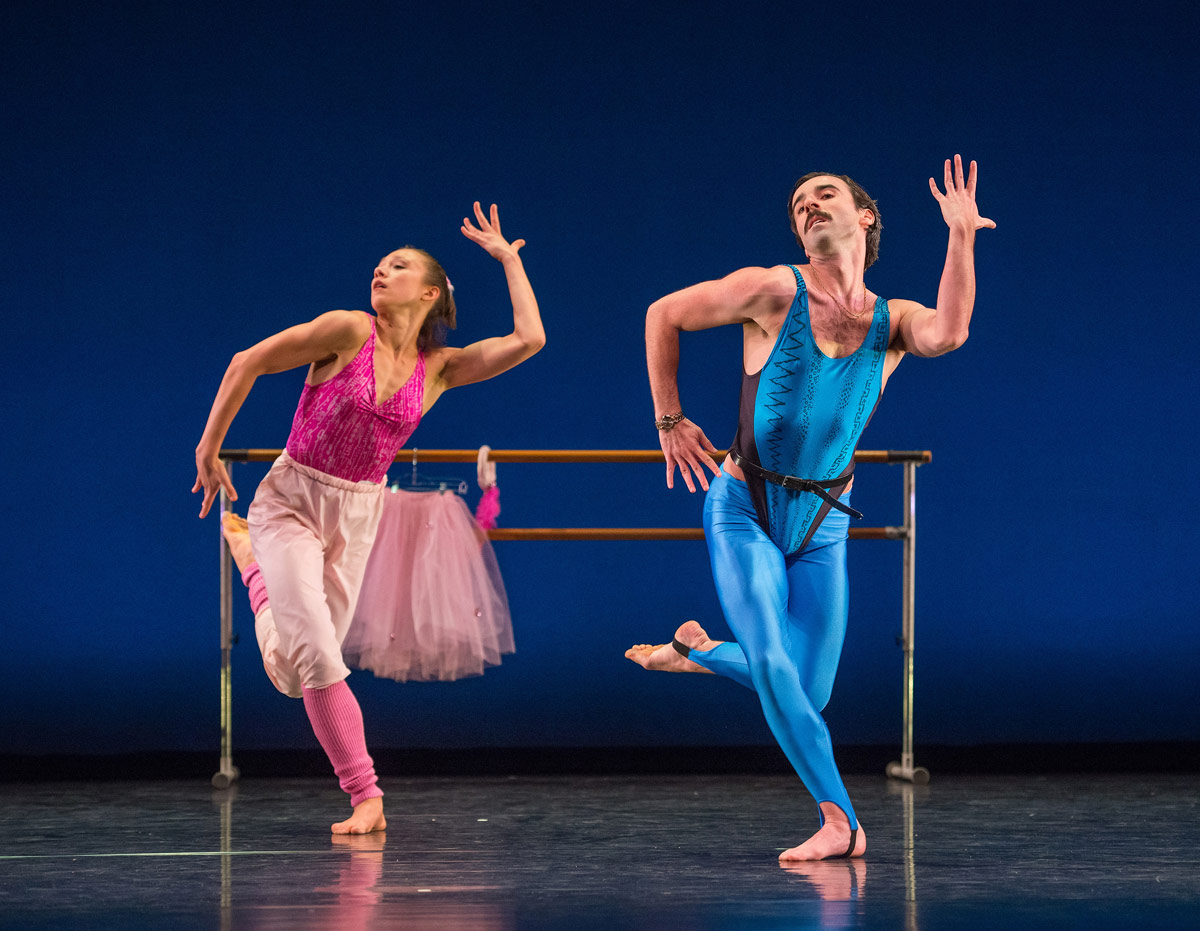
© Stephanie Berger. (Click image for larger version)
The new piece, Pure Dance Items, looks like it still needs some time to settle on the dancers. It’s one of Morris’s super-complex puzzle dances, like his Right of Spring. It’s all about the beats and the beats between the beats. The music is a group of selections from Terry Riley’s Salome Dances for Peace. Lines cross, phrases repeat and ricochet, groups subdivide into sub-groups. There is a watching theme; dancers sit on a stool, alone or in groups, echoing the movements of the ensemble. It’s a sophisticated work but for now still an opaque one, in which the individual movements don’t quite merge into a coherent whole.
In addition to performances by the Carnatic singers Bombay Jayashri and T.M. Krishna, the percussionist V. Selvaganesh, and various film screenings, the programming of the festival includes two dance companies from India, Kerala Kalamandalam and Nrityagram. Nrityagram specializes in Odissi, from Orissa, and Kerala Kalmandalam in Kathakali, from the southwestern coastal state of Kerala. Both derive their principles from the Natya Shastra, a treatise on theatre and dance dating back over two thousand years.

© Kevin Yatarola. (Click image for larger version)
And yet, they couldn’t be more different. Kathakali, performed by men, is a dance-drama form in which elaborate Hindu epics are performed over the course of night-long marathon performances. The dancers, who are all men, wear huge, colorful costumes with hoop skirts, heavy makeup and papier maché facial appliqués, brass fingernails (on the left hand), as well as enormous crowns. (Odissi is danced by women and is much more lyrical and composed.)
At the festival, the Kerala Kalamandalam performed a short episode – only an hour long – from the Mahabharata in which a slighted wife (Draupadi, represented by a man) goes to Krishna to plead for revenge for her mistreatment at the hands of two brothers, Duryodha and Dussasana, from a rival family. Krishna intercedes on her behalf and encourages Draupadi’s husband (Bhima) to go to war with her abusers. The ensuing battle is one of the most exciting things I’ve ever seen on a stage.
I had never seen a Kathakali performance before, and assumed that because of the heavy costumes and makeup, it would be quite a static affair. Not at all. The dancer/actors are forceful, masculine, dynamic. In fact, they seem almost larger than life, so that when they move, they do so with the power of giants. The dancer in the role of Krishna (Kalamandalam Mukundan) was particularly impressive; he rose up high on the balls of his feet and rocked side to side, galloped around the stage, smacked the floor with the outsides of his feet, balanced on one leg, sprung into the air, squatted. All the dancers used a highly codified hand language, as expressive as words. Their eyebrows fluttered and arched with amusement, anger, or dismay. Draupadi’s look of disgust at her mistreatment was a masterpiece in and of itself. One of the dancers, Kalamandalam Roudrabheema made even the skin of his cheeks tremble.

© Kevin Yatarola. (Click image for larger version)
The story comes to a climax in a battle between Bhima and Dussassana. Roudrabheema (Bhima) growled like a lion, and the two men went at each other with clubs, bumped hips, raised trembling fists, and finally engaged in hand to hand combat – meanwhile the drums were going wild – until finally, Dussassana fell. Then came the gory part: Bhima dug his long nails into Dussassana’s gut; when they emerged, they were covered in blood (presumably dye), which he proceeded to lick with gusto. (The victim was still twitching, and even raised an arm in protest.) Blood poured out of Bhima’s mouth; he was like a lion with a dead antelope. Then he pulled out the man’s entrails (red rope). It was an orgy of violence and blood.
I’ve never seen anything like it. The combination of stylized storytelling and down-and-dirty gore and guts; the continuous crescendo of drumming; the mixture of formality and casualness onstage. The dancers enter hidden behind a curtain, held by two stagehands, like a magic trick. But when a scene ends, they just walk off, casually. The men holding the curtain make no attempt to disappear; I saw one of them scratch his shoulder as he waited for the big reveal. The ropes representing Dussassana’s entrails were kicked to the side unceremoniously when they no longer served. There were barely any props. No stage lighting. And no supertitles, which would have been helpful. The instruments were simple: drums, cymbals of various sizes, the human voice, and, at one point, a conch. It was marvelous.












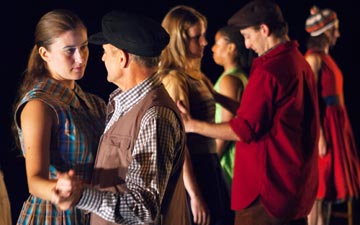



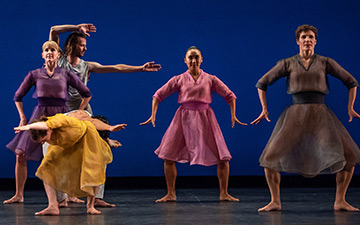
Marina – wonderful first experience, equally skillfully reported. A couple of out of print books are available on the subject if you’re interest. One by E. Krishna Iyer,
published in England in the late ’50’s or early ’60’s. A second was compiled for
the first U.S. tour of the Kerala Kalamandalum, published bythe Americna Society of Eastern Arts. Beryl de Zoete’s The Other Mind also covers both Kathakali and
Brhata Natyam – Shivaram, my Kathakali teacher, is mentioned in the de Zoete book.
He was oneo the first graduates of the school.